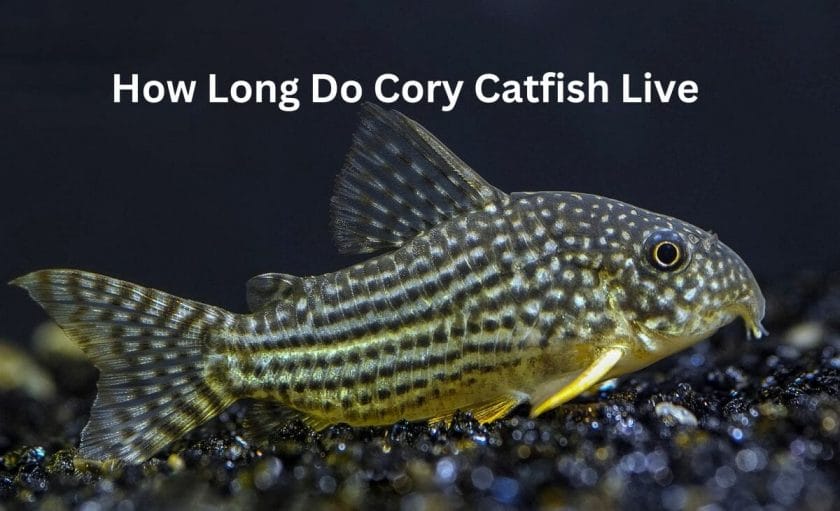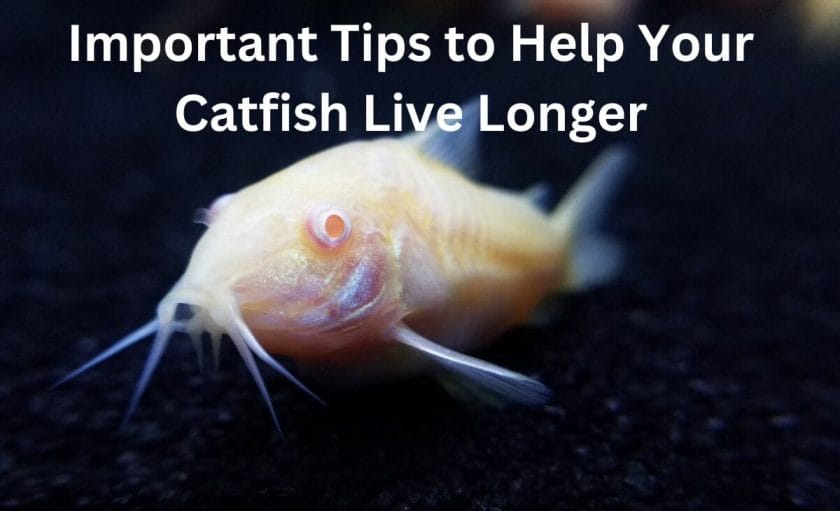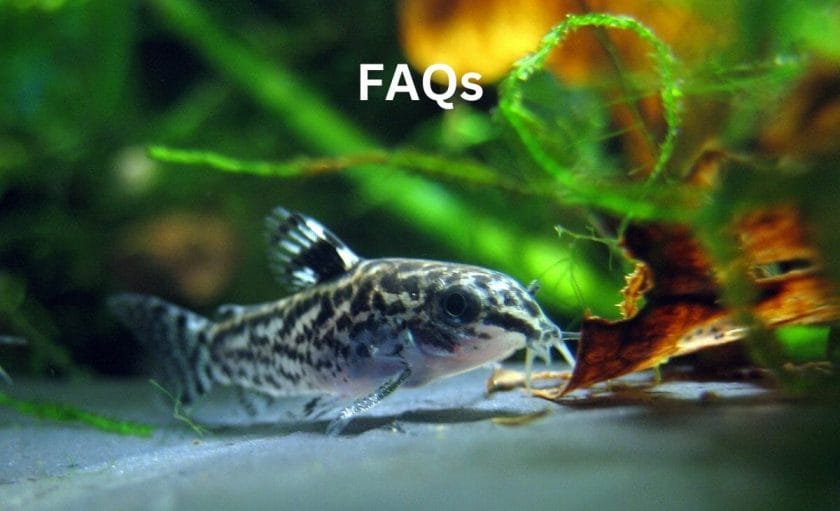Cory catfish are a great beginner fish for almost any aquarium; however, one factor that many aquarists consider is how long their fish will live. After all, getting the most enjoyment and longevity out of your pets is important.
Cory catfish can live 5-7 years on average in captivity. In rare cases, they can live for 10-15 years given the right diet and environment.
There are a lot of important details that determine how long a cory catfish will live, and there are many steps you can take to make sure your cory catfish lives a long and healthy life.

Table of Contents
How Long Do Cory Catfish Live

Generally, cory catfish are long-lived, thriving for about 5-7 years in captivity. In some cases, they can live longer.
Here’s a quick breakdown of popular cory catfish species and how long they live.
| Cory Catfish Species | Lifespan |
|---|---|
| Pygmy Cory | 3 years |
| Panda Cory | 10 years |
| Albino Cory | 5-8 years |
| Sterba’s Cory | 15-20 years |
| Julii Cory | 5 years |
| Bandit Cory | 5 years |
| Dwarf Cory | 5 years |
| Pepper Cory | 5-10 years |
| Bronze Cory | 10 years |
| Three-Stripe Cory | 10 years |
| Adolfo’s Catfish | 3-5 years |
| Salt and Pepper Cory | 5 years |
| Schwartz’s Catfish | 3-5 years |
| Emerald Catfish | 5 years |
| Duplicate Cory | 5 years |
| Skunk Cory | 5 years |
| Elegant Cory | 5 years |
| Leopard Catfish | 5 years |
| Rust Cory | 5 years |
| Corydoras Punctatus | Up to 8 years |
| Corydoras Similis | 5 years |
| Agassiz’s Cory | 3-5 years |
| Corydoras Nanus | 5 years |
| Corydoras Kanei | 5 years |
| Slate Cory | 5-7 years |
| Corydoras Melini | 5 years |
| Corydoras Loxozonus | 5 years |
| Bluespotted Cory | 5-7 years |
| Blue Cory | 5 years |
| Green Gold Catfish | About 5 years |
| Corydoras Reticulatus | 5 years |
| Spotted Cory | 5 years |
| False Spotted Cory | 3-5 years |
| Corydoras Atropersonatus | 5-8 years |
| Pink Cory | 5 years |
| Corydoras Haraldschultzi | 5 years |
| Corydoras Davidsandsi | 3-5 years |
| Twosaddle Cory | 3-5 years |
| Tailspot Cory | 5 years |
| False Network Catfish | 3-5 years |
| Xingu Cory | 7-15 years |
| Corydoras Robineae | 5 years |
| Corydoras Semiaquillus | 5 years |
| Sychr’s Catfish | 6 years |
| Corydoras Undulatus | 5 years |
| Black Band Catfish | 3-5 years |
| Corydoras Septentrionalis | 5 years |
| Guapore Cory | 3-4 years |
| Kali Walu | 5 years |
| Britski’s Catfish | 5-8 years |
| Blacktop Cory | 3-5 years |
5 years is a good estimate for most common species of cory catfish, although some can live longer. With proper care, nutrition, and environment, it’s possible your tank cories can thrive for a decade!
Which Species of Cory Catfish Lives the Longest?

Some species of cory catfish live longer than others, largely due to their genetics. Of the cories, the Sterba’s Cory tends to live the longest, thriving for 15-20 years in optimal conditions.
Note the word ‘optimal’ here. The most important factors for any Cory are excellent water conditions, a stress-free environment, and bountiful nutrition.
Factors contributing to the Sterba’s Cory lifespan include its size, genetics, and appearance in nature. Sterba’s get up to 2.5 inches, which isn’t large by any standard, but it’s bigger than some other cory species.
Generally, smaller creatures have faster metabolisms, which can cause them to live shorter lives. The pygmy Cory at an adult size of 1.3 inches, for example, only lives about 3 years.
The Sterba’s Cory also has great genes and a strong immune system, helping avoid diseases and stress-related illnesses to some extent. The Sterba’s Cory is also a naturally occurring species, which can sometimes, but not always, signal a longer life.
Species that are created by gene editing can tend to suffer from deformities and illnesses, or they may simply be less competitively viable. The species still prefers slightly soft, acidic water, but tank-bred Sterba’s cories have adapted to a wide range of tank conditions, signaling their hardiness.
In a tank environment, these factors are not as prevalent as in the wild, but they are still relevant. Notably, the Bronze Cory, Panda Cory, and Three-Stripe Cory have been known to live for about 10 years, dependent on excellent tank conditions and care.
Important Tips to Help Your Catfish Live Longer

Regardless of species, there are some common factors that can positively or negatively impact a cory’s lifespan.
Diet
Just as with humans, fish need a varied and balanced diet. Cories will munch on leftover detritus, but it should not serve as their primary source of food. Cories are omnivorous and need protein-rich and vitamin-rich food.
These may include any of the following:
- Fish flakes or pellets
- Bloodworms
- Shrimp pellets
- Algae wafers
- Bottom feeder tablets
- Vegetables
Left to fend for themselves, cories may be outcompeted for food by middle and top-swimming fish. As such, it’s important to target feed them to make sure they are getting the nutrients they need.
Algae wafers are great, for example, because carnivorous fish won’t bother with them, and the wafers will quickly sink to the bottom of the tank. Hikari Algae Wafers are my go-to for cory catfish and other herbivorous/omnivorous catfish.
One good way to make sure your cories are getting enough is through the simple power of observation. Watch them during feeding time to make sure they are getting some food, and target feed with bottom feeder pellets, wafers, or veggies 1-2 times per week.
Of course, most beginner aquarists swing the other way and overfeed their fish, leading to ammonia spikes and wildly inconsistent water parameters. In general, if there’s leftover food 30-60 minutes after you feed, you should reduce the amount you are feeding.
Water Parameters
Perhaps the most mechanically important skill to learn as a new aquarist is managing your water parameters. Cory catfish are pretty hardy and can survive in a range of tank conditions, but that doesn’t mean you shouldn’t be actively monitoring and adjusting tank parameters.
Here’s a quick breakdown of what your cories need.
| Temperature Range | 70 – 82 F |
| pH | 6.0 – 8.0 |
| Minimum Tank Size | 10 gallons |
| Diet | Omnivorous |
| Water Hardness | 5 – 10 dGH |
| Substrate Preference | Sand, gravel (no sharp gravel) |
| Ammonia | 0 ppm |
| Nitrites | 0 ppm |
| Nitrates | Under 40 ppm |
Keep in mind that this is a general guideline, and you should conduct individual research on your preferred species of cory.
Of these parameters, beginners generally struggle with the nitrogen cycle (ammonia, nitrites, and nitrates).
Ammonia and nitrites are both deadly to your fish and should be kept at 0 ppm. If your ammonia and nitrites are zero, it means your tank is producing enough ‘good’ bacteria in your filter to make the water safe.
The byproduct of this ‘good’ bacteria is nitrate, which is still harmful, but not as much so. Anything under 40 ppm is acceptable, although the ppm may vary depending on your tank size and other tank parameters.
To lower your nitrates, you will need to dilute the water by removing some of your aquarium water and replacing it with treated water. Some aquarists recommend as much as 50% water changes each week, while others suggest only diluting the water by 25% biweekly.
Again, each tank is its own ecosystem, so your test kit should be your guide for when to schedule your water changes. You will also need to treat the water accordingly with Prime or a similar detoxifier.
This helps to temporarily bind the ammonia in the newly added water so that the filter bacteria can keep up; otherwise, your fish will inevitably suffer from ammonia poisoning or exposure to toxic metals found in tap water.
Environment
The tank environment is pertinent to keeping your cories alive for longer. One of the most common causes of disease in fish is stress. When a fish is stressed, their immune system is compromised, and their quality of life diminishes. As such, it’s important to cater the tank environment to suit your cory’s needs.
First, cories are shoaling fish and should be kept in groups of 5 or more. They won’t school, per se, but they prefer to be around others of their kind. A 20-gallon tank is suitable for a group of cories, although you will need to get a larger one if you’re planning on keeping a community tank.
Regardless of whether your tank has semi-aggressive fish or not, it’s important to provide plenty of hiding places for your fish by using creative hardscaping and decorations. This is your opportunity to be creative while at the same time providing an ideal, natural landscape for your fish.
I can’t stress the importance of plants enough. Not only are they the most natural decoration you can get (duh), but they also help oxygenate the tank and provide hiding places for your fish. Even if your cories don’t need a place to hide, having a secluded place to get away from the hustle and bustle of busy tank life is always a boon.
Tankmates
Cories are also very peaceful fish and can be subject to harassment by other semi-aggressive and aggressive fish. Keeping them with an Oscar, for example, is not a good idea because the Oscar will nip their fins. Not only is the damage inflicted by an aggressive fish is an open invitation for infection, but it also causes–you guessed it–additional stress, which can shorten a cory’s lifespan.
In short, always research the fish you want to include in your tank before you go full steam ahead. Doing so can save you the headache of returning them later–or worse yet, having some of your fish die because they are unequivocally incompatible.
FAQs

Do Cory Catfish Live Longer in Captivity?
Cories that live in tanks tend to live longer than their wild counterparts due to the absence of predators, better water quality (hopefully), and consistent access to food.
Do Cory Catfish Live Longer than Other Catfish?
Cory catfish are somewhat short-lived compared to other catfish, as the average catfish lifespan is anywhere from 5-20 years, although some cories are exceptions to the rule. Their small size and thus fast metabolism likely contribute to a shorter lifespan.
Conclusion
Cory catfish are great in most tanks, and their hardy nature makes them a great long-term pet. Under the right circumstances, they can survive well over a decade, although it’s important to note that most cories will only live for 5-7 years.
Be sure to review the helpful information provided in the tables above to see how long each different species of common cory catfish will live!